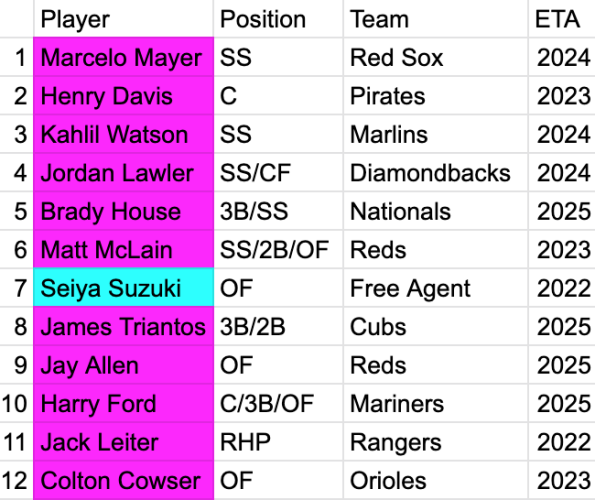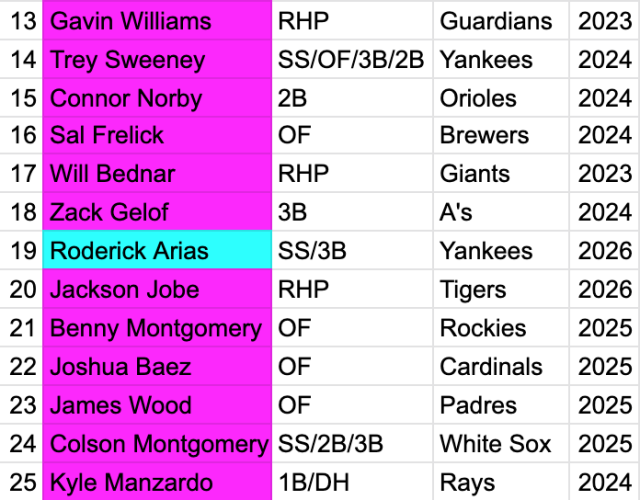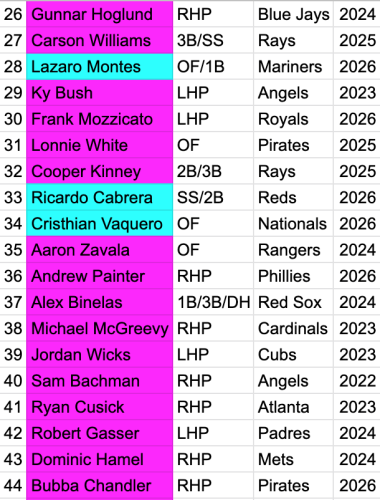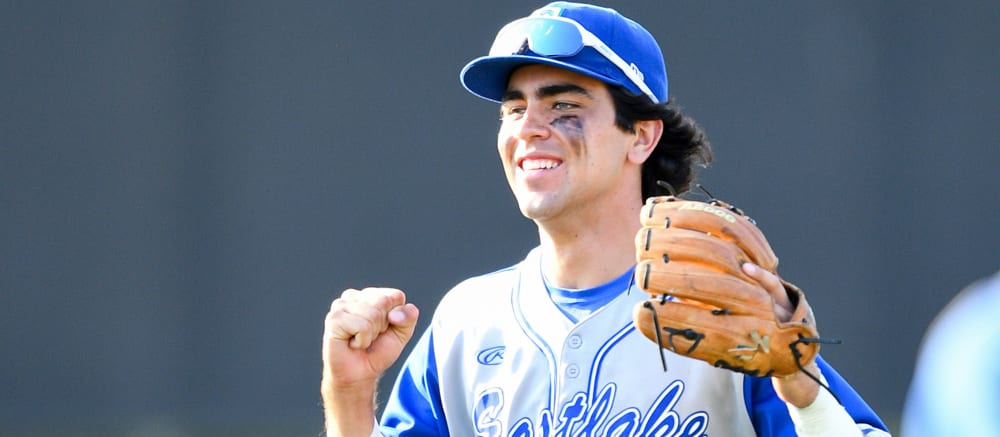This article is part of our Farm Futures series.
This is the second-annual First-Year Player Draft Blueprint for dynasty leagues. Accompanying this article is the fully updated FYPD Board, which I would recommend opening in a separate tab. I've provided descriptions of every player there, along with ETAs. The Board features 100 players, but you should be able to get through your FYPD without going too far past my top 50. If you want more detail or opinions on any players, don't hesitate to ask me in the comments or on Twitter.
If you listened to me last year, you had a better than average chance of ending up with Nick Gonzales or Cade Cavalli and you would have dodged the Ha-Seong Kim landmine, but you also might have reached on Wilman Diaz or Ed Howard. This is a tough thing to get right, but I think this piece should serve as a useful guide, even if you don't want to follow it rigidly.
The massive update to the top 400 prospect rankings will be completed Feb. 1. I'm really proud of how things are looking at this stage, and I don't want to rush it out. However, I've included a projected range for the prospects I'll be discussing in this article.
There are many ways to approach a first-year player draft, but here are my general biases:
- Elite college hitters are the absolute cream of the crop. Not every class has more than one or two of these. They get to the big leagues
This is the second-annual First-Year Player Draft Blueprint for dynasty leagues. Accompanying this article is the fully updated FYPD Board, which I would recommend opening in a separate tab. I've provided descriptions of every player there, along with ETAs. The Board features 100 players, but you should be able to get through your FYPD without going too far past my top 50. If you want more detail or opinions on any players, don't hesitate to ask me in the comments or on Twitter.
If you listened to me last year, you had a better than average chance of ending up with Nick Gonzales or Cade Cavalli and you would have dodged the Ha-Seong Kim landmine, but you also might have reached on Wilman Diaz or Ed Howard. This is a tough thing to get right, but I think this piece should serve as a useful guide, even if you don't want to follow it rigidly.
The massive update to the top 400 prospect rankings will be completed Feb. 1. I'm really proud of how things are looking at this stage, and I don't want to rush it out. However, I've included a projected range for the prospects I'll be discussing in this article.
There are many ways to approach a first-year player draft, but here are my general biases:
- Elite college hitters are the absolute cream of the crop. Not every class has more than one or two of these. They get to the big leagues two-to-three years earlier than their prep counterparts and we can have much more confidence in their hit tool grades, as they will have typically played in a tough conference or will have experience in the Cape Cod League.
- Prep hitters and elite international hitters who sign on Jan. 15 are the next best players to invest in. You can get superstars from these subsets, but they are typically at least four years away from the majors and have the potential to completely fizzle out early on in pro ball.
- Top college pitchers are the next best players to go after. They are risky, but they can join big-league rotations in two-to-three years. We can have more confidence in their command grades and they are less reliant on projection.
- I have no patience for hitters from college or high school who come into pro ball and strike out too much at age-appropriate levels, especially when that was a big concern for them as an amateur. It's very rare that a guy is overmatched early and then figures it out.
Unfortunately, this class is very weak. The best college hitter was a catcher (Henry Davis) and the international class isn't all that exciting. The strength of the class is prep hitters, which is typically a very risky subset. Seven of my top 10 FYPD prospects are prep hitters, and there's a lot to like with all of them, but we won't be seeing them in the majors until 2024 at the earliest.
This year's J-15 international signing class is difficult to get too excited about. Outside of the top four guys (Roderick Arias, Lazaro Montes, Ricardo Cabrera, Cristhian Vaquero), you're better off using a FYPD pick on a player who will open in a full-season league so that you can get a sense of what you have. It's not worth stashing the non-elite guys for three-plus months while they are not playing. You're better off trying to grab the Dominican Summer League pop-up guys in July while trying to hit on a stateside prospect in the meantime.
Seiya Suzuki
Before getting to the Blueprint, I think it's worth discussing Seiya Suzuki briefly, as he is his own entity in the player pool. I don't rank international signees who are 25 or older at the time they sign on the top 400 prospect rankings, as I don't consider them prospects and I don't think I'm remotely close to an expert on these types of players. However, they do need to be ranked on a set of FYPD rankings. Suzuki is 27 and will open the year in the majors, and I understand if just that fact alone pushes someone to take him in the FYPD. However, if anyone tells you with any kind of confidence how Suzuki will perform in the majors, they're full of it. We don't know. Even the team that signs him doesn't know. We can guess, and when making that guess, we should acknowledge that NPB pitching is significantly worse than big-league pitching. I was essentially out on Ha-Seong Kim last year because he was coming from the KBO, which is a further step down from NPB, and you'd be going against my advice if you took Suzuki where you'll need to take him in drafts this year. For instance, if you can just trade the pick you are going to use on Suzuki for any of Andrew Benintendi, Harrison Bader, Hunter Renfroe, Jorge Soler, Ian Happ, Enrique Hernandez or Josh Rojas, that'd be preferable for me. I assume you could get at least some of those guys for top-three FYPD picks this year. If trading isn't your thing and you're set on making the pick for you, the only way I'd take Suzuki was if I had an old roster that was a strong 2022 contender.
1
If you can trade this pick for any of Brayan Rocchio, Josh Lowe, Nick Yorke, Nick Gonzales, Aaron Ashby or Luis Matos (I excluded some prospects that I assume would be instant declines) and the other manager's last pick in the FYPD, that'd be a big score. Those prospects are all in a tier ahead of Marcelo Mayer. If you can't pull off such a deal, you should just should grab Mayer.
Options: Trade for a better prospect; select Mayer
Top-400 Range: 21-25
2-7

There are smart people who don't think Mayer is the top player in this FYPD class, so it's quite possible he is available with the second or third pick. In that scenario, it's an easy call to grab him. I will have Henry Davis, Kahlil Watson, Jordan Lawlar, Brady House and Matt McLain all within the 35-50 range on the top 400 update, so there's very little separation in this range. If you feel strongly about one of those five (or Suzuki), then don't let me sway you in a different direction. There's also a chance that a non-FYPD guy like Dustin Harris or Coby Mayo is available (I've had people asking about Harris specifically), and this is the range for those guys (Harris and Mayo are preferable to everyone except Mayer). I do think it would be a mistake to take anyone else in this range, however.
Options: Take Mayer if he falls; take one of Davis, Watson, Lawlar, House, McLain, Suzuki
Top-400 Range: 35-50
8-15
I don't expect any of Davis, Watson, Lawlar, House or Suzuki to be available in this range, but I'd bet McLain will be available here more often than not. If he's gone for your pick, there are still some strong options available. Jack Leiter will probably be picked in the top seven, but one of James Triantos, Jay Allen, Harry Ford or Colton Cowser should be on the board until around pick 15.
Options: Take McLain if he falls; take one of Triantos, Allen, Ford, Leiter, Cowser
Top-400 Range: 51-75
16-40

It's quite possible that one of Triantos or Allen is available after the 15th pick, but I wouldn't bank on it. I'm guessing Ford and Cowser will be gone at this point. Gavin Williams is riskier than Leiter, but I think he has a higher ceiling, and he makes for a nice target in the late teens. The players most likely to be prime values after pick 20 are Connor Norby, Will Bednar, Zack Gelof, Joshua Baez, Colson Montgomery and Kyle Manzardo. On the flip side, Trey Sweeney, Sal Frelick, Roderick Arias, Jackson Jobe, Benny Montgomery and James Wood are not guarantees to make it out of the first round, and are certainly unlikely to slide far in the second round.
Options: Take Triantos or Allen if one falls; take one of Williams, Sweeney, Norby, Frelick, Bednar, Gelof, Arias, Jobe, B. Montgomery, Baez, Wood, C. Montgomery, Manzardo
Top-400 Range: 80-174
41-75

There's a slight chance players like Norby, Bednar, Gelof, Baez or C. Montgomery are available after pick 40, and I think it's likely that you can get Manzardo after pick 40. If all of them are gone, I'm guessing there will be non-FYPD prospects who will be available that I'll have ranked ahead Gunnar Hoglund, Carson Williams or Lazaro Montes. Hopefully you're not drafting until after my big update to the top-400, but please reach out if you'd like some help on that front before Feb. 1.
Options: Take Norby, Bednar, Gelof, Baez, C. Montgomery or Manzardo if one falls; take the best non-FYPD prospect available; take one of Gunnar Hoglund, Carson Williams, Lazaro Montes, Ky Bush, Frank Mozzicato, Lonnie White, Cooper Kinney, Ricardo Cabrera, Cristhian Vaquero, Aaron Zavala, Andrew Painter, Alex Binelas, Michael McGreevy, Jordan Wicks, Sam Bachman, Ryan Cusick, Robert Gasser, Dominic Hamel, Bubba Chandler
Top-400 Range: 175-300
71-100

I'm guessing you can complete your FYPD without venturing outside my top 44 FYPD rankings or my top 300 prospects. Montes, Bush, Gasser and Hamel seem particularly likely to be available beyond where I have them ranked. If they're all gone and you still have a pick left, I'm pretty sure you can grab T.J. White, Cooper Bowman or Jose Torres late. This is another range where the best player available probably isn't a FYPD player -- it might be a non-FYPD prospect or a big-league reliever, that type of thing.
Options: Take Manzardo, Montes, Bush, Gasser or Hamel if one falls; take a non-FYPD player; take one of White, Bowman, Torres or one of the many players ranked below them.
Top-400 Range: 301-400










